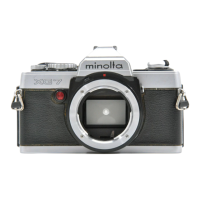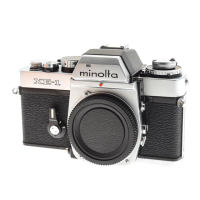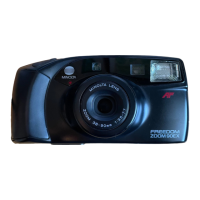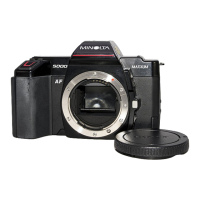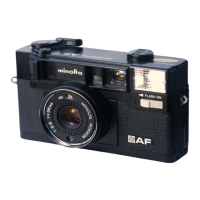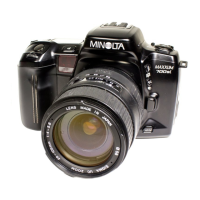REMOVING THE FRONT-PLATE/
MIRROR-CAGE ASSEMBLY
As mentioned earlier, the front plate,
mirror cage, shutter, and flex circuit come
out as a unit. What's more, you don't
have to unsolder a single wire. If you
haven't already done so, remove the front
decorator plate; a slit at the top, Fig. 42,
allows you to slightly spread the sides of
the front decorator plate to clear the lens-
mounting ring. The stop-down button at
the side of the front-decorator plate will
be loose.
The small plate you can now see at the
side of the lens mount. Fig. 43, covers the
air-damping piston; the plate simply clips
into place. In action, the air-damping
piston slows down the upward move
ment of the mirror; that gives the
diaphragm time to stop down. Then, after
the diaphragm has reached the proper
f/stop, the mirror mechanism opens the
memory switch.
Now remove the rewind-shaft support
plate. Fig. 42, by taking out its three
screws. Then peel off the rewind-side
front leatherette. To completely remove
the wind-side front leatherette, you must
take off the self-timer lever. However,
you need only peel back the leatherette
far enough to reach the two front-plate
screws.
At the bottom of the camera, remove
the screw holding the reset switch S1.
Lift aside the S1 assembly with the two
yellow wires still attached. Also lift aside
the battery compartment after taking out
its two screws. Then remove the two
screws holding the lower circuit board.
Finally take out the four front-plate
screws. Notice the position of the one
slotted screw — the locating screw in the
upper wind-side corner. You can now
separate the front-plate/m irror-cage
assembly from the body casting, Fig. 44.
Before replacing the assembly, charge
both the shutter and the mirror cage.
Charge the shutter by pushing the
shutter-cocking lever from right to left in
Fig. 44. Then charge the mirror by
pushing the mirror-tensioning lever from
left to right, Fig. 44.
OPERATING THE FRONT-PLATE/
MIRROR-CAGE ASSEMBLY
You can still operate the assembly at
the mechanical settings. Set the speed
knob to either "0 " or "B ." Then push the
release button to release the mirror.
At the mechanical settings, the release-
slide latch, Fig. 45, moves away from a
notch in the release slide. Now the release
slide can move down its full distance and
release the mirror. However, when you
select an electronically controlled speed,
the release-slide latch swings under the
release-slide notch as shown in Fig. 46.
Here, the release-slide latch prevents the
release slide from moving down far
enough to mechanically release the mirror.
So, to release the mirror electronically,
you'll have to connect a 3V power supply
to the circuit. Connect the positive
power-supply lead to the battery-
compartment terminal; connect the
negative power-supply lead to any metal
portion of the front plate.
There's one more connection you must
make. Normally, the lower circuit board
makes its ground connection through the
body casting. But now, with the lower cir
Figure 42
Figure 43
Figure 44
SHUTTER-COCKING LEVER
MIRROR-TENSIONING
LEVER

